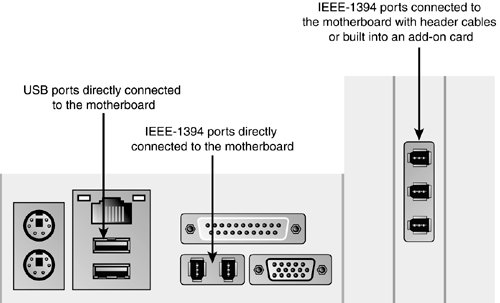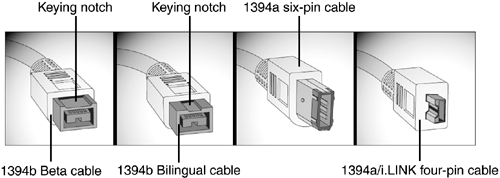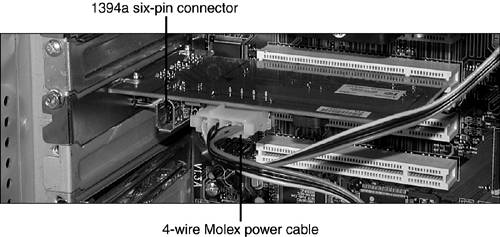IEEE-1394 (FireWire)
| < Day Day Up > |
| IEEE-1394 is a family of high-speed bidirectional serial transmission ports that can connect PCs to each other, digital devices to PCs, or digital devices to each other. The most common version of IEEE-1394 is known as IEEE-1394a, and is also known as FireWire 400. Sony's version is known as i.LINK . At 400Mbps, IEEE-1394a is one of the fastest and most flexible ports used on personal computers. IEEE-1394a can be implemented either as a built-in port on the motherboard or as part of an add-on card (see Figure 8.30). Figure 8.30. Two typical locations for IEEE-1394a ports on the rear of a typical ATX-class computer. Some IEEE-1394a add-on cards also provide an internal port for the growing number of internal IEEE-1394 devices. A faster version of the IEEE-1394 standard, IEEE-1394b, was introduced in early 2003. Also known as FireWire 800, 1394b ports and devices transfer data at 800Mbps. Future versions will reach higher speeds.
IEEE-1394 Ports and CablesStandard IEEE-1394a ports and cables use a 6-pin interface (four pins for data, two for power), but some digital camcorders and all i.LINK ports use the alternative 4-pin interface, which supplies data and signals but no power to the device. Six-wire to four-wire cables enable these devices to communicate with each other. IEEE-1394b ports use a 9-pin interface. There are two versions of the IEEE-1394b port: The Beta port and cable are used only for 1394b-to-1394b connections, whereas the Bilingual cable and port are used for 1394b-to-1394a or 1394b-to-1394b connections. Beta cables and ports have a wide notch at the top of the cable and port, whereas Bilingual cables and ports have a narrow notch at the 1394b end, and use either the 4-pin or 6-pin 1394a connection at the other end of the cable. All four cable types are shown in Figure 8.31. Figure 8.31. 1394b and 1394a cable connectors compared. IEEE-1394Compatible Devices and Technical RequirementsIEEE-1394compatible devices include internal and external hard drives , digital camcorders (also referred to as DV camcorders), Web cameras , MP3 players (such as Apple's iPod) and high-performance scanners and printers, as well as hubs, repeaters, and SCSI to IEEE-1394 converters. IEEE-1394 ports support hot-swapping, enabling you to add or remove a device from an IEEE-1394 port without shutting down the system. 1394 ports can also be used for networking. Up to 16 IEEE-1394 devices can be connected to a single IEEE-1394 port through daisy-chaining. Most external IEEE-1394 devices have two ports to enable daisy-chaining. Windows 98/Me/2000/XP all include IEEE-1394 support; Windows 95 and Windows NT 4.0 and earlier NT versions do not. IEEE-1394 cards are PCI-based and require the following hardware resources:
The exact IRQ and memory address range used by a particular IEEE-1394 card can be determined by using the Windows Device Manager. When an IEEE-1394 card is installed, a device category called 1394 Bus Controller is added to the Device Manager, and the particular card installed is listed beneath that category. Installing an IEEE-1394 CardTo install and configure the card
|
| < Day Day Up > |
EAN: N/A
Pages: 310
- Chapter I e-Search: A Conceptual Framework of Online Consumer Behavior
- Chapter VI Web Site Quality and Usability in E-Commerce
- Chapter XI User Satisfaction with Web Portals: An Empirical Study
- Chapter XV Customer Trust in Online Commerce
- Chapter XVIII Web Systems Design, Litigation, and Online Consumer Behavior


